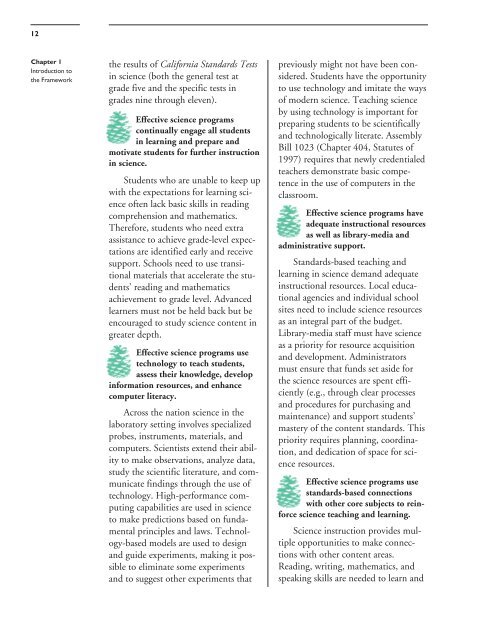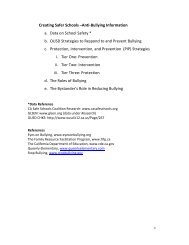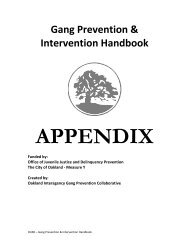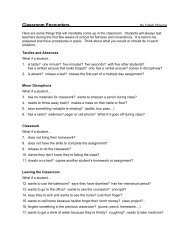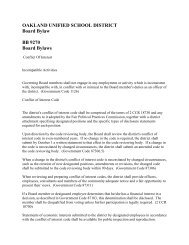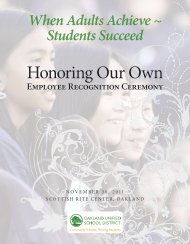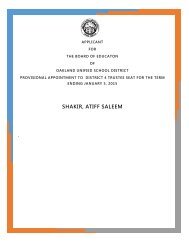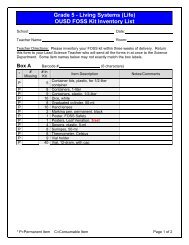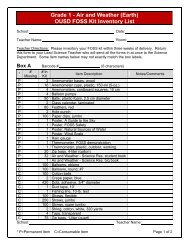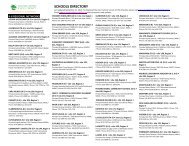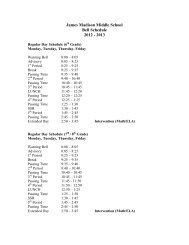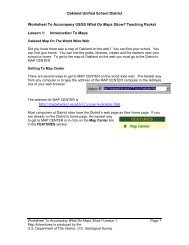Science Framework, part 1 - Free Downloads (CA Dept of Education)
Science Framework, part 1 - Free Downloads (CA Dept of Education)
Science Framework, part 1 - Free Downloads (CA Dept of Education)
- No tags were found...
Create successful ePaper yourself
Turn your PDF publications into a flip-book with our unique Google optimized e-Paper software.
12Chapter 1Introduction tothe <strong>Framework</strong>the results <strong>of</strong> California Standards Testsin science (both the general test atgrade five and the specific tests ingrades nine through eleven).Effective science programscontinually engage all studentsin learning and prepare andmotivate students for further instructionin science.Students who are unable to keep upwith the expectations for learning science<strong>of</strong>ten lack basic skills in readingcomprehension and mathematics.Therefore, students who need extraassistance to achieve grade-level expectationsare identified early and receivesupport. Schools need to use transitionalmaterials that accelerate the students’reading and mathematicsachievement to grade level. Advancedlearners must not be held back but beencouraged to study science content ingreater depth.Effective science programs usetechnology to teach students,assess their knowledge, developinformation resources, and enhancecomputer literacy.Across the nation science in thelaboratory setting involves specializedprobes, instruments, materials, andcomputers. Scientists extend their abilityto make observations, analyze data,study the scientific literature, and communicatefindings through the use <strong>of</strong>technology. High-performance computingcapabilities are used in scienceto make predictions based on fundamentalprinciples and laws. Technology-basedmodels are used to designand guide experiments, making it possibleto eliminate some experimentsand to suggest other experiments thatpreviously might not have been considered.Students have the opportunityto use technology and imitate the ways<strong>of</strong> modern science. Teaching scienceby using technology is important forpreparing students to be scientificallyand technologically literate. AssemblyBill 1023 (Chapter 404, Statutes <strong>of</strong>1997) requires that newly credentialedteachers demonstrate basic competencein the use <strong>of</strong> computers in theclassroom.Effective science programs haveadequate instructional resourcesas well as library-media andadministrative support.Standards-based teaching andlearning in science demand adequateinstructional resources. Local educationalagencies and individual schoolsites need to include science resourcesas an integral <strong>part</strong> <strong>of</strong> the budget.Library-media staff must have scienceas a priority for resource acquisitionand development. Administratorsmust ensure that funds set aside forthe science resources are spent efficiently(e.g., through clear processesand procedures for purchasing andmaintenance) and support students’mastery <strong>of</strong> the content standards. Thispriority requires planning, coordination,and dedication <strong>of</strong> space for scienceresources.Effective science programs usestandards-based connectionswith other core subjects to reinforcescience teaching and learning.<strong>Science</strong> instruction provides multipleopportunities to make connectionswith other content areas.Reading, writing, mathematics, andspeaking skills are needed to learn and


